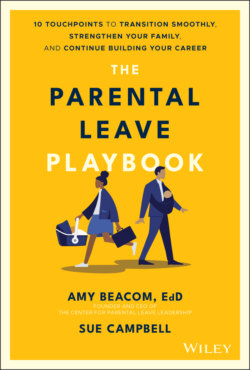Читать книгу The Parental Leave Playbook - Sue Campbell - Страница 31
Chapter Two The 10A Transition Touchpoints Framework
ОглавлениеYOU MIGHT HAVE already asked yourself, “Why isn't there a manual for this becoming a working parent thing?” Everybody has this reality check at some point. For me it was when I left the hospital and looked down at my son all scrunched in his car seat and thought, “What the heck do I do now?” For Kisha, it was when she felt her baby's first kick and realized this was really happening. For Jay, it was when he saw his partner constantly breastfeeding and realized it was on him to care for their toddler while also working full time from home. Many people ask for a manual when they confront changing a first diaper or giving a first bath. Yet even with this nearly universal desire, there still isn't a universal manual. As mind-boggling as this may be, there is a good reason: every child and every parent is different.
What are we really asking for when we yearn for a manual? Do we really want someone to tell us what to do? Do we care, or even listen, if we don't think it applies to us? What makes that magic moment possible when something clicks and we can finally hear for the first time what we may have been told 10 times before?
I worked with Caitlin when she had her second child. After he was born, she reported, “Wow, it's so much easier this time around. I'm much more relaxed because I know what to expect and I know that some of the things that were so scary before pass quickly. I really wish I had known this with my first.” She hadn't believed her large family when everyone told her not to worry so much with her first—that she would find her way. They had even spent time giving her advice and showing her how to do certain things. She didn't listen to them because she didn't trust that they could understand the unique experience she was going through. Like most new parents, when Caitlin was offered an informal manual, she wasn't ready to receive it. With the birth of her second child, Caitlin was able to pay less attention to the critical internal voice that had accompanied her the first time around, telling her she was doing it wrong. She was more confident because she had learned that she could do this, and do it well. I could hear her contentment and see her whole body relaxing when she talked about it: “I'm not worrying that he hasn't eaten enough or that he's sleeping at the wrong time or about the hundred other things I used to think about. I'm just looking at him and thinking, how did I get so lucky?”
Caitlin was describing the comfort, confidence, and expertise we all get when we have lived through something difficult and discovered we not only made it through, but we got wiser along the way. Qualitative researchers talk about the value of learning from our unique and individual lived experience, through which we gain personal, even profound, firsthand knowledge about ourselves and the world around us, which enables us to grow and develop. We can be told or read about something, but it is in the doing that we learn.
In the consulting world, experiential learning (sometimes called action learning) is the gold standard when it comes to skill building and leadership development programs because it relies on lived experience to ensure what is being learned sticks and is carried forward. This is why I say (pun intended) the parental leave transition is the mother of all experiential learning programs and companies would be wise to see it that way.
As part of my research and theory-building for my doctorate over a decade ago, I wondered if we could capture the learning opportunities of this massive experience in a way that would support new parents to find their footing faster and bring what they were learning in warp speed at home into work, and, conversely, if there was a way for them to bring their expertise from work into what they were learning at home. Was there a way to allow for the uniqueness of the individual experience in a predictable and replicable process? I found there was.
